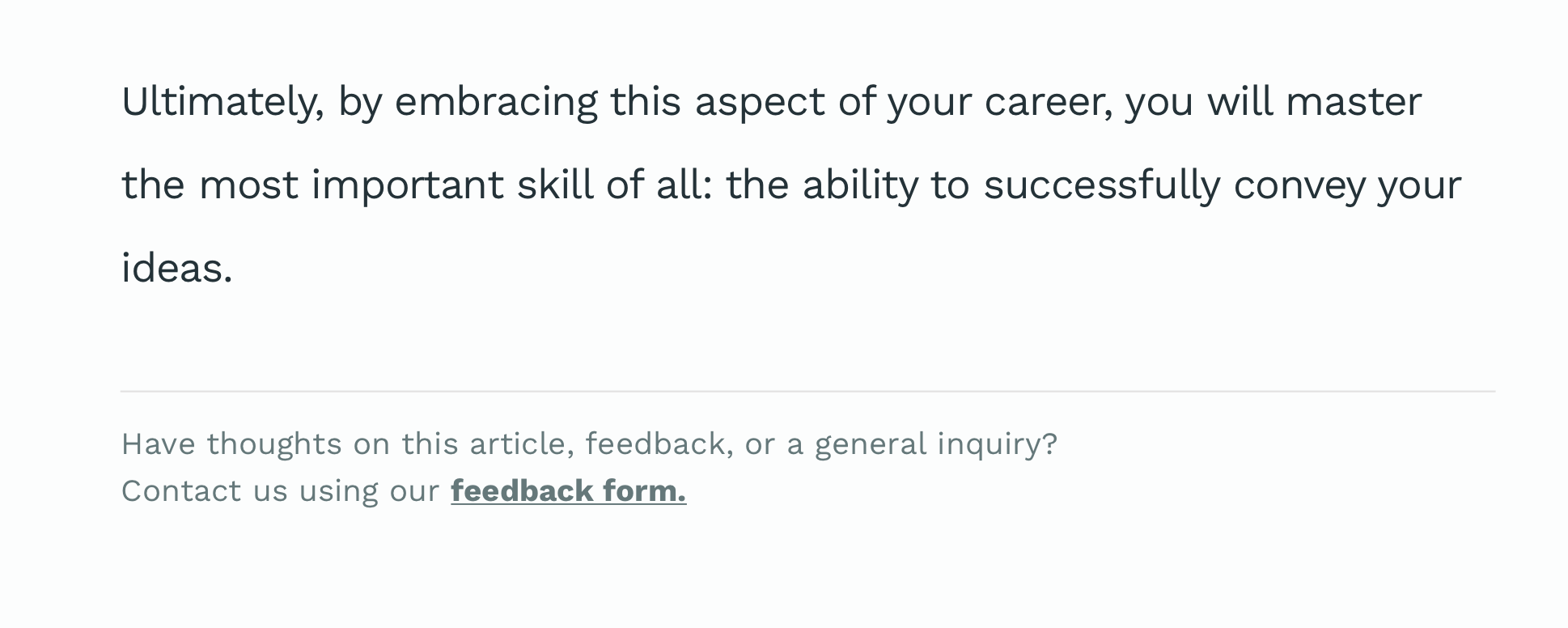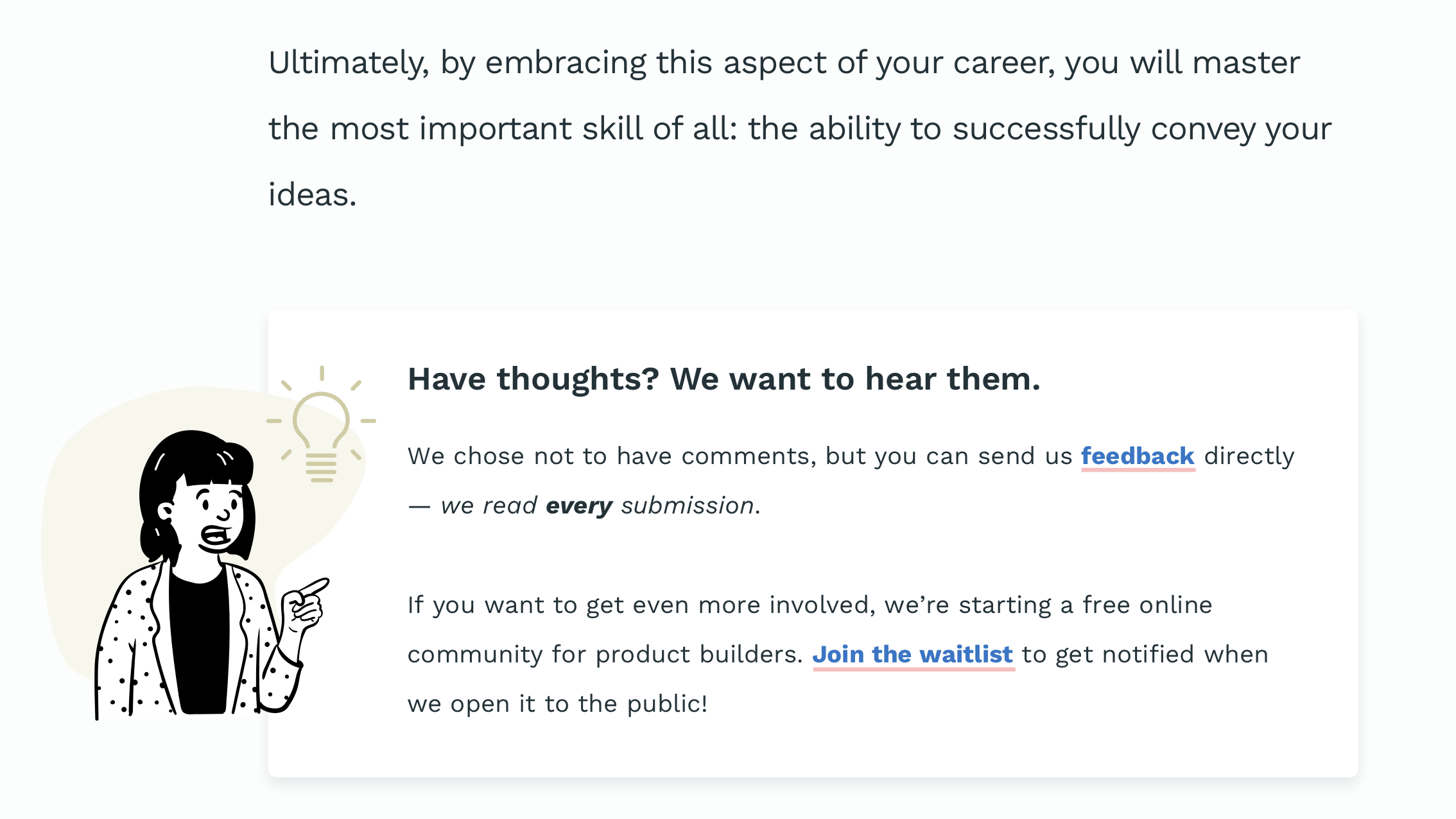Context-Pairing: For Long-Lasting Foundational Features
P.S. Lab Notes are written for and organized by Persona Types👤 persona types – we wanted to sort our content by the way people think and not across topics, because most topics are beneficial for people of all different backgrounds in product building. Our method allows for readers to hone in on what suits them, e.g. via perspective, lessons learned, or tangible actions to take. .
Context-pairing is a method of implementing a feature that ensures all the context known to date has been considered before starting work.
Thinking about context for product features
Your feature should align to company mission, values, and all available context such as: near-term business priorities, product launches, your users’ behavior, etc.
In this way, you can ensure that the “why” behind the product feature is well-defined before focusing on the “how” and getting into the execution details at all. It’s similar to perfecting the core shapes of a drawing before layering with polishing techniques like shadows and contrast.
Use this checklist to ask the right questions and establish a well-defined “why” for your next feature:
- Company Mission and Values
- Does this feature align with our company’s mission statement?
- Does it reflect and reinforce our core values?
- Will it help us fulfill our long-term vision?
- User Needs and Behavior
- Have we gathered and analyzed data on our users’ behavior and preferences?
- Does this feature address a real user need or pain point?
- Is it consistent with our users’ expectations and mental models?
- Business Priorities and Goals
- Does this feature support our current business priorities and goals?
- Is it aligned with our product roadmap and strategy?
- Will it contribute to key metrics like user engagement, retention, or revenue?
Now that we have some definition around the term, let’s look at how it can be applied in practice.
An example of context-pairing on this site
The goal – create feedback loops on our article pages
In one of the many iterations of our article pages (aka Lab Notes), we had to decide if we wanted to allow comments or not on the site. We are invested in the part of the Internet where there are humans and not bots, so we decided not to allow comments. We also felt that comments do not allow for intimate or real-time communication between author and reader. So this decision also made us ask ourselves:
“How will we still enable feedback loops within this community?”
We wrestled with this concept for a while and thought of solutions.
One of those was a feedback form. We wanted readers to give us feedback on the article they just read. This would start an email thread where we could be super active and committed to the conversation, while avoiding some of the negative sides of public discourse.
We also wanted a way for readers to communicate with us and connect with each other in a shared environment. This led us to start building our Discord community, Juice Box, around the same time.
Now we had two related features with similar goals.
How context-pairing helps us improve
When we first added the feedback form call to action at the bottom of our lab notes, we had a plain text, easy-to-miss sentence with an underlined link. When I showed the design to friends, I found myself scrolling past it too quickly.

How did we end up burying this thing that was very important to us, our mission, our values, our community? Because we lost sight of the bigger context around the feature.
Words were not enough. This feature needed to stop people and make them think. It needed to give them multiple ways to engage, and be a fun, exciting part of the page. We also wanted it to align with our human-first values and friendly tone.
Taking all this into account, we went back to the drawing board and produced this version:

This version gives the reader multiple options to get involved, features a friendly character, and is considerably more attention-grabbing! This aligns way better with how important the area should feel.
Why you should (or shouldn’t) use context-pairing
Long-term, sustainable product development
Context-pairing is ideal for companies that:
- Plan to stay in business for a long time
- Aim to deliver high value to their users
- Want to keep their promises and maintain trust
This approach relies on commitment from leadership to a long-term, sustainable product development strategy. It’s especially important for core functionality that will be around for years to come.
High upfront costs, high impact
Context-pairing can be highly influential but also increases the scope of work considerably. This often deters decision-makers or executors from wanting to use this approach.
The purposeful scope-creep may seem expensive, and many people will try to convince you to take the easy way out and forget the extra context. However, it’s more costly in the long run to repeatedly return to the same area to “fix” issues.
Time for a housekeeping analogy. In Marie Kondo’s The Life-Changing Magic of Tidying Up, she recommends gathering all items of a category in one space, and then doing the task of sorting and filtering. By considering all those items at once, you avoid having to adjust as you uncover new ones. Seeing them laid out allows you to consider how they all need to work together, and saves time.
This is the same for product development – your key features are intertwined, and considering them together helps your team make holistic, decisive moves.
When to avoid context-pairing
Context-pairing may not be the best choice in all situations. For temporary or legacy features, they may not be around long enough to justify the added execution time. You could also be under a tight deadline because of acquisitions or crucial company events.
And finally, an iterative approach may be a better fit. Iterating is helpful when you need information that isn’t available yet, like real-world data.
Balancing context-pairing and iteration
In practice, a combination of context-pairing and iterative approaches can be effective:
- Use context-pairing for core, long-term features that significantly impact your product and align with your company’s mission and values.
- Apply iterative approaches for smaller, more experimental features or when you need to validate assumptions and gather data quickly.
- You could also use context-pairing first, then apply an iterative approach to marginally improve the feature.
The key is to understand the trade-offs and make informed decisions based on your specific circumstances, priorities, and goals. By balancing context-pairing and iteration, you can create a product development process that is both strategic and adaptable.




